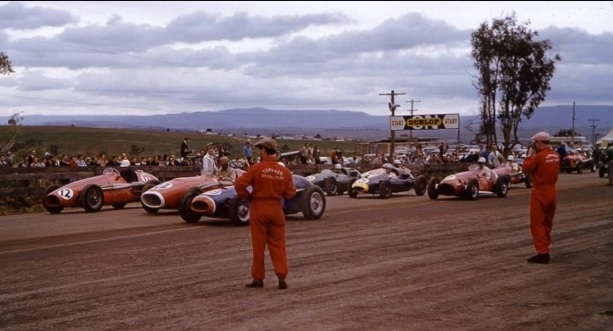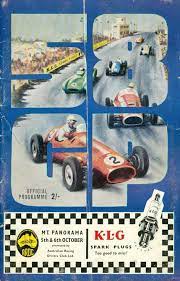by Brian Goulding

It is 65 years since the Australian Racing Drivers Club ran the 23rd Australian Grand Prix at Mount Panorama, Bathurst. At this fabulous meeting not only was the 1958 Australian Grand Prix decided but the 1958 Australian Tourist Trophy was run and won. The TT was the quaint old name given to the Australian Sports Car Championship. Australian Motor Sports magazine described the October weekend as “the best motor racing meeting for some time”.

The Tourist Trophy was run over 26 laps of the 3.8-mile (6.115 kilometre) circuit at 3.10pm on Sunday, October 5. Many of the fancied entries were Jaguar-powered, cars like Ron Phillips’ Cooper Jaguar, New Zealander Frank Cantwell in his Tojero Jaguar, Bill Pitt and Jack Murray in D-Type Jaguars, and Frank Matich’s C-Type. There were three current model DB3S Aston Martins for David McKay, Tom Sulman and Warren Bloomfield. Nor could Doug Whiteford’s 3 litre ex-works Maserati 300S be discounted.
At the start Bill Pitt pushed his D-Type into the lead from David McKay’s DB3S, Derek Jolly’s little 1500cc Lotus 15 and Doug Whiteford’s 300S. Whiteford easily worked his way up to the lead, but on lap 10 travelling at around 150mph (245km/h) Doug was caught by a gust of wind on Conrod Straight’s the second hump. There was no Chase chicane in those days. Whiteford spun out of control straight through Murray’s Corner and down the escape road to Bathurst. He bounced off four fences, almost being flung out of the car though fortunately he suffered only bruising.
This left McKay comfortably in the lead from Jolly and Phillips. After a brief rain shower this was the final order when the chequered flag dropped. In Behind the Wheel (1960), Mackay wrote, “Those last 60miles (96kms) were the longest miles I’d ever driven.”

Until 1958 the Australian Grand Prix had always been a classic Formula Libre race – a run-what-you-brung event in which sports cars were often highly competitive. As an example of the increasing sophistication of Australian racing and the growing number of competitive sports/racing cars in the country, sports cars of any type were banned from the 1958 AGP. Even though the field was now made up of open wheelers only, there was tremendous variety in the best Formula Libre tradition.
There were big cars like the Alf Harvey 4.5 litre V12 OSCA which had run in the 1951 Italian GP. There were small cars like the Ralt Vincent of Noel Hall that finished third in Heat One but failed to start in the GP itself. There were old cars like Ray Walmsley’s 1934 Grand Prix Alfa Romeo P3 whose original straight 8 supercharged engine was long gone. Like the Ern Seeliger Maybach, the Curly Brydon Ferrari, while the Ted Gray Tornado Walmsley was relying on a new 283 cubic inch (4.6-litre) Corvette V8 to provide reliable lightweight power. Merv Neal’s Cooper (chassis F2/20/58) was probably the newest car – it even had disc brakes all round.
The field for the AGP was split into two heats which were held on Saturday afternoon. Heat One appeared to be for the slowest half of the field and Heat Two for the fastest.
Heat One was initially led by Allan Ferguson driving the spectacular Holden-powered MG Special known as “Isk”. He was chased by the little air-cooled twin-cylinder Ralt of Noel Hall and the Jaguar Special driven by Jack Robinson. Alf Harvey started slowly from pole position in the ex-Prince Bira OSCA 4500G. This car was famously fragile but as the heat progressed Harvey gained confidence and speed. He won the race with a fastest lap of 2.59.5 and a registered speed through the flying quarter mile of 133.33mph (214.57km/h).
Heat Two was for the fast cars. Gray was on pole in the Tornado Corvette, but Jones’ Maserati led the field through Hell Corner from Mildren (Cooper) and Davison (Ferrari). On lap two Jones dropped oil on the exit of the Cutting, Mildren spun and was hit by New Zealander Tom Clark (Ferrari Super Squalo). Gray hit the lead on lap two and won easily from Jones and Davison. Gray’s fastest lap was 2.50.0.
Jones jumped into the lead at the start, from Davison and pole man Gray. These three were 7 seconds clear of the rest after only one lap. New Zealander Clark passed Neil’s Cooper Climax on lap two and settled into a lonely fourth place.
By lap 10 Gray was eight seconds clear of the battling Jones/Davison duo. 50 seconds behind was the Clark Ferrari with the Seeliger (Maybach) and Hawkes (Cooper Holden) fight another four seconds back. Clark dropped back and pitted on lap 18 with overheating. He continued but was much slower.
Alf Harvey in the OSCA was getting faster (2.58.0 fastest lap) but blew a spark plug clean through the bonnet and had to retire. Having led from lap three Gray pitted to report strange handling on lap 22. From all reports the pit stop was shambolic. An attempt was made to get fuel into the tank but it largely failed. Did they not have a funnel or was the funnel too small? Whatever the reason very little fuel got into the fuel tank.
Gray was sent back out but after glancing off a barrier on the next lap returned to the pits to have some chassis bolts tightened. After two slow laps the car was retired although Gray achieved a fastest lap of 2.45.5 and a top speed of 155.17mph (249.722kph).
With the Tornado out Stan Jones was left in the lead. Lex Davison was all over him but Jones held him off even with a non-operating clutch in the Maserati. Coming down the mountain on lap 26 the Jones Maserati trailed thin, then thick blue smoke out of Forrest’s Elbow. Davison swept by and then slowed to coast to victory. He was just over 2 minutes ahead of runner up Ern Seeliger in the Maybach Corvette with Tom Hawkes 6 seconds back in the Cooper Holden.
In his victory speech at the presentation dinner Lex Davison referred to the Cooper Climaxes as “Anti-Climaxes”. History would show that a small rear engine car was the way of the future, even in Formula One, Davison joining the move in 1961 when he bought a T51 Cooper Climax.
Incidentally it has been 25 years since the ARDC last ran a race meeting at Mount Panorama, Bathurst. That was the 1998 AMP Bathurst 1000. Also it is just over 25 years ago, in August 1998, that Amaroo Park hosted its last meeting. The registered office of the ARDC was at Amaroo Park in Annangrove from 1970 to 1996.

